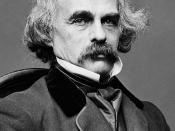The authors, Shirley Jackson and Nathaniel Hawthorne, both frequently use symbols within their stories 'The Lottery' and 'Young Goodman Brown.' Symbols are utilized as an enhancement tool to stress the theme of each story. Hawthorne uses names and objects to enhance the theme, and Jackson mainly utilizes names to stress the theme, although she does have one object as a symbol of great importance to the theme. The stories both contain symbols describing evil. The majority of Hawthorne's symbols describe religion (both good and evil), but Jackson's symbols reflect the evil nature within society as a whole. There exists symbolic acts in each story. The short stories both share the use of symbols, but the symbols are used to express different thoughts in ones mind while reading them.
The stories 'Young Goodman Brown' and 'The Lottery' both use names as symbols. Hawthorne uses the names Young Goodman Brown and Faith to portray nice, descent people.
The name Faith alone implies a faithful and Christian individual as stated 'And Faith, as the wife was aptly named,' (211). Jackson uses the name Mr. Graves throughout her story, he is the coordinator of the lottery. She needs not give any explanation to the name, as it speaks for itself (a symbol of death). Various other names are used as symbols within each story, however, these mentioned are the most significant names to the theme. The stories each contain names, objects, and acts as important symbols.
Hawthorne uses the names to stress good people, but relies heavily on objects to portray Satanism. The object of obvious Satanism is the staff (a cane) mentioned throughout the story. It is clearly identified when the old traveler throws it down in the sentence 'it assumed life, being one of the rods which its...



Good depiction of Hawthorne's use of symbolism
I think that this author did a good job in identifying which symbols are used to portray different elements of the story. An example is when he mentions that Satanism is present in the story but not directly mentioned, just implied by the staff in the story.
2 out of 2 people found this comment useful.